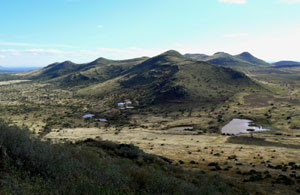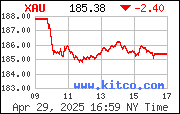 Sound QA/QC procedures are important both for the company to know what is happening with the samples and for the investors to know that industry "Best Practices" are being met or exceeded.
Sound QA/QC procedures are important both for the company to know what is happening with the samples and for the investors to know that industry "Best Practices" are being met or exceeded. The following points illustrate the path samples follow from initial core drilling to final announcement of results:
On The Property
1. Drill hole locations are laid out in the field by Orko geologists. Pad construction is supervised and fore-sight / back-sight markers are set to align the direction of drilling.
2. Drilling is being conducted by Major Drilling de Mexico, a subsidiary of Major Drilling Group International Inc., with experienced drillers. They are using two rigs on La Preciosa, a Longyear-44 and a Longyear-38. The diamond drill core is HQ diameter for the total length of the drilling with the Longyear-44. For the Longyear-38, holes start with HQ and reduce to NQ at approximately 260 metres depth. Both of these drill core sizes provide a large sample as recommended for the testing of precious metal deposits.
3. Down-hole surveys are conducted at 50 metre intervals down the drill hole using a Reflex survey device to measure azimuth and dip of the hole.
4. It is the driller's responsibility to insure that the core in the boxes is in the correct order and to mark the length tags for each rod-length of core, as well as mark the inside of the core boxes where the tag is located.
5. Core boxes are picked up from the drill site by Orko personnel and taken to the drill core logging facilities on the property.
6. Boxes are then laid out on logging tables and checked to make sure that the core is continuous and in the right order in each box. Core boxes are cleaned at this stage to remove drill grease.
7. Measurements of core between rod-length tags are taken to determine drill core recovery.
8. The proportions of core fragments greater than 10 cm and 20 cm in length are determined to obtain RQD values. This data is entered into an RQD log. While this information will not be used in the exploration stage, it will be valuable information for future mine design indicating where competent ground and broken ground conditions can be expected.
9. All core boxes and lids are then clearly labelled with the "from" and "to" lengths in metres.
10. Geological logging of the core is conducted and sample positions are marked to conform with lithological/alteration changes. Sample numbers are written inside of the core boxes corresponding to pre-printed sample tags.
11. Chalk lines are marked down the axis of the core and the boxes for sampling are moved to the cutting area. Diamond saw blade cutters are used to cut the core in half. This method is preferred over core splitters for precious metal deposits.
12. The core boxes are returned to their places in order on the logging tables. Strong plastic rock sample bags are labelled with sample numbers on the outside and the sample tags inserted inside, then ½ the core is placed in their respective sample bags.
13. The boxes from which samples have been taken are marked with a red asterisk and placed in sequence on the metal core racks.
14. The sample bags are moved to the testing table for determination of specific gravity. An SG value is determined for every sample and samples with high sulphide and/or barite content, or possessing vugs, are tested twice to confirm higher or lower SG readings. This information is used when determining tonnage.
15. Standards are weighed and inserted every 10th sample. Standards Orko-1 and Orko-3 were made from ore-grade material from the stockpile. Standards Orko-2 and Orko-4 were made from barren basaltic rock and represents a blank value.
16. Sample bags are then closed and inserted in large sacks. These sacks are labelled with the sample range and company name, with the laboratory instruction sheet placed in sack #1 of the sampling batch.
Laboratories
The city of Durango, Mexico, is fortunate to have the services of several analytical laboratories, including the certified labs SGS Mineral Services and Inspectorate. Depending on the work loads of the labs, batches can be sent to either lab. SGS Lab in Durango
17. The sacks of samples are delivered by Orko personnel to the preparation laboratory of SGS Mineral Services in Durango, Mexico.
18. From this point onward, SGS takes responsibility for the samples. SGS is an accredited and well respected analytical company. The Durango lab is where the samples are crushed and a sub-sample is pulverized. The pulverized pulp is placed in kraft sample bags and the un-pulverized portions are returned to the original sample bags.
19. Batches of the sample pulps are shipped by DHL couriers to the Toronto, Canada laboratories of SGS. Orko personnel pick up the remainder of the crushed samples, referred to as "sample rejects", which are taken back to La Preciosa for storage. The sample rejects are thus available for re-testing when required.
SGS Lab in Toronto, Ontario, Canada
20. In Toronto, the sample pulps are analysed by Inductively Coupled Plasma (ICP) for 40 elements. Gold is tested by Fire Assay and silver is tested by Atomic Absorbtion Spectrometry (AAS). Each method has a lower and upper calibration range for which the results are accurately determined.
21. Sample results falling out of the calibration range for the elements Au, Ag, Pb, Zn, Cu and Ba are re-analysed by methods with higher calibration ranges. This is true for silver >300 g/t, gold >10 g/t, and Pb, Zn, Cu and Ba >10,000 ppm.
22. SGS also performs a "duplicate analysis" on every 12th sample, insuring that there is at least one duplicate run with every batch.
Inspectorate Lab in Durango
23. Near the end of 2006, Inspectorate established a new preparation lab in Durango, with a 700 sample-per-run drying oven. Inspectorate is an accredited and well respected analytical company, thus Orko has added Inspectorate to the list of analytical service providers. The sacks of samples are delivered by Orko personnel to the preparation laboratory of Inspectorate Labs in Durango, Mexico.
24. From this point onward, Inspectorate takes responsibility for the samples. The Durango lab is where the samples are crushed and a sub-sample is pulverized. The pulverized pulp is placed in kraft sample bags and the un-pulverized portions are returned to the original sample bags.
25. Batches of the sample pulps are shipped by courier to the Sparks, Nevada, USA laboratories of Inspectorate. Orko personnel pick up the remainder of the crushed samples, referred to as "sample rejects", which are taken back to La Preciosa for storage. The sample rejects are thus available for re-testing when required.
Inspectorate Lab in Sparks, Nevada, USA
26. In Sparks, the sample pulps are analysed by Inductively Coupled Plasma (ICP) for 30 elements. Gold and silver are tested by Fire Assay (FAA). Each method has a lower and upper calibration range for which the results are accurately determined.
27. Sample results falling above the calibration range for the elements Au, Ag, Pb, Zn, Cu and Ba are re-analysed by methods with higher calibration ranges. This is true for silver >200 g/t, gold >10 g/t, and Pb, Zn, Cu and Ba >10,000 ppm.
28. Inspectorate also performs a "duplicate analysis" on every 15th sample, insuring that there is at least one duplicate run with every batch.
Orko in Vancouver and Durango
29. Results are tabulated on spreadsheets and e-mailed to Orko geologists. Originals of the assay certificates are sent in hard-copy format to Vancouver.
30. Upon receiving the completed analytical results, geologists then extract the duplicate and standard samples for examination of expected values versus tested values.
31. The spreadsheet information for the drill hole samples is then matched with the sampling intervals and geological observations for interpretation.
32. Results of the merged data are then sent to Orko management, along with the interpreted true width of the structures.
33. Orko management periodically prepares news releases to make public the information from the drilling in a format compatible with NI 43-101 standards. A "Qualified Person" signs-off on news releases containing technical data.
YeOldGoldNugget's links of interest
- One Indicator The Government Can’t Ignore
- Seven market lessons guaranteed to improve your trading
- 5 Markets & 5 Ways To Improve Your Trading Profits In the coming years ahead
- 90 Second Gold Lesson (Video)
- 100% Returns on a Canadian Stock (Video)
- Introducing the Perfect Portfolio
- What does winter hold for Crude Oil?
- All 7 Traders Whiteboard videos
- Free Email Trading Course Copy
- New Video: ETF GLD is analyzed
- Register for all the latest Trader's Blog postings Today.










![Live 24 hours silver chart [ Kitco Inc. ]](http://www.kitco.com/images/live/silver.gif)






.png)













